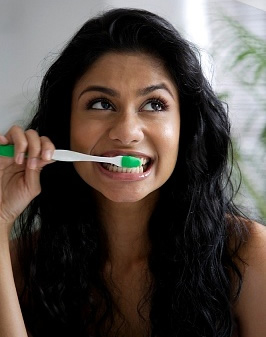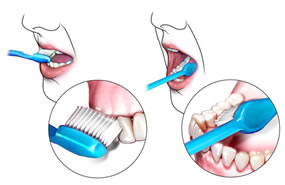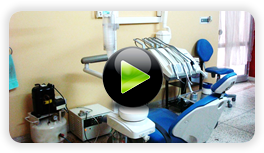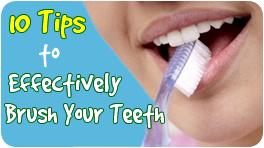 Use a good toothbrush. Your toothbrush should have soft nylon bristles and a small head. Soft bristles are gentler on your gums and will flex more easily to reach between the teeth while a small head allows you to reach all areas of your mouth.
Use a good toothbrush. Your toothbrush should have soft nylon bristles and a small head. Soft bristles are gentler on your gums and will flex more easily to reach between the teeth while a small head allows you to reach all areas of your mouth.
Replace your toothbrush regularly. You should get a new one every 3 months, or as soon as the bristles start to splay out and lose their shape. You should also replace your toothbrush if you’ve recently recovered from an illness such as a cold or the flu.- Wet your toothbrush slightly.
- Squeeze a pea-sized amount of toothpaste onto your toothbrush. Your toothpaste should contain fluoride. If brushing is painful, switch to a toothpaste formulated for sensitive teeth.
- Try to concentrate on one tooth at a time. As you go around your mouth, try to focus on one tooth for a few seconds. When that’s done, move on to the next one.
- Start with the front of your teeth. Hold the brush so that it’s parallel to your lips, then tilt it upward by about 45 degrees. Start with your top front teeth, and work around each side of your mouth in a back-and-forth circular motion, brushing the outer side of each top tooth. Move to the bottom row of teeth, and tilt the toothbrush up by about 45 degrees. Work around each side of your mouth, brushing the outer side of each bottom tooth.
Wiggle the bristles along the gum line. This is extremely important, as gum disease starts here. Brush gently to avoid damaging your gums. Pressing harder does more damage than good. Make sure to get behind the molars at the back, where bacteria like to hide.  Brush your molars. Position the toothbrush so that it’s perpendicular to your lips, or so that the bristles are resting on top of your bottom molars. Work the toothbrush in an in-and-out motion, and move from the back of your mouth to the front. Repeat on the other side of your mouth. When the bottom teeth are clean, flip the toothbrush over and work on the top molars.
Brush your molars. Position the toothbrush so that it’s perpendicular to your lips, or so that the bristles are resting on top of your bottom molars. Work the toothbrush in an in-and-out motion, and move from the back of your mouth to the front. Repeat on the other side of your mouth. When the bottom teeth are clean, flip the toothbrush over and work on the top molars.- Brush the “inside” of your teeth. After you’ve brushed the top of your molars, flip the brush so that the bristles are resting along the inner side of one of your back bottom molars. Angle the bristles toward the gums a bit, and brush each molar, moving from the back of your mouth to the front. Work both sides, top and bottom.
When you reach your front bottom teeth, tip the toothbrush so that the head of the toothbrush is pointing downward, toward your tongue, and brush each tooth. For your front top teeth, the head of the toothbrush should point to the roof of your mouth. - Gently brush your tongue. After you’ve cleaned your teeth, use the bristles of your toothbrush to gently clean your tongue. (Don’t press too hard, or you’ll damage the tissue.) This helps keep bad breath away.
- Gently brush your tongue. Position your toothbrush so that the bristles are resting on top of your tongue, and gently move it in an in-and-out motion. (Don’t press too hard, or you’ll damage the tissue.)
- Rinse out your mouth. Take a sip of water from a disposable cup, or cup your hands under the faucet. Swish it around your mouth, and spit it out.
- Rinse your toothbrush. Hold your toothbrush under running water for a few seconds, or (if you have a bowl or cup of water) wiggle it around under water for a bit.
- Use mouthwash. Take a small sip of mouthwash, swish it in your mouth, and spit it out. Be careful not to swallow any.



